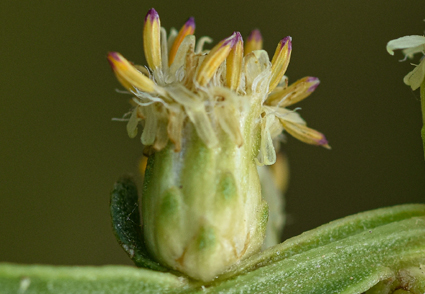Abstract
During the taxonomic revision of ‘carquejas’ (Baccharis sect. Aphyllae and B. sect. Caulopterae) from Uruguay, and following a comprehensive study of the protologues, type materials, and recently collected specimens, we conclude that B. sagittalis and B. heeringiana are distinct species. Therefore, we propose the recognition of B. heeringiana as an independent taxonomic entity. Baccharis heeringiana has wider wings than B. sagittalis (6.5–20 mm vs. 2–6 mm wide), longer corollas in staminate florets (5.5–8 mm vs. 3.5–4.5 mm long), longer styles in pistillate florets (4–6.5 mm vs. 2–2.6 mm long) and distinct pappus elements (barbellate vs. scabrid bristles). It grows in waterlogged sites with hydromorphic soils in Eastern South America from Bahia, in Northeast Brazil, and south to the Eastern Uruguayan departments of Cerro Largo and Rocha. A distribution map, field photos, and an illustration are also provided.
References
- Ariza Espinar, L. (1973) Las especies de Baccharis (Compositae) de Argentina central. Boletín de la Academia Nacional de Ciencias 50 (1–4): 175–305.
- Bachman, S., Moat, J., Hill, A.W., de la Torre, J. & Scott, B. (2011) Supporting Red List threat assessments with GeoCAT: geospatial conservation assessment tool. (Version BETA). ZooKeys 150: 117–126. https://doi.org/10.3897/zookeys.150.2109
- Baker, J.G. (1882) Compositae. III. Asteroideae, Inuloideae. In: Martius, C.F.P. von, Eichler, A.W. & Urban, I. (Eds.) Flora brasiliensis, vol. 6 (3,87). F.Fleischer, München,Wien, Leipzig, pp. 1–134, pl. 1–44.
- Barroso, G.M. (1976) Compositae, Subtribo Baccardinae Hoffmann, Estudo das espécies ocorrentes no Brasil. Rodriguesia 28 (40): 3–207.
- Barroso, G.M. & Bueno, O. (2002) Compostas—5. Subtribo: Baccharidinae. In: Reitz, R. (Ed.) Flora Ilustrada Catarinense. Herbário Barbosa Rodrigues, Itajaí, pp. 765–1065.
- Beentje, H.J. (2010) The Kew Plant Glossary: An Illustrated Dictionary of Plant Terms. Royal Botanic Gardens, Richmond, 160 pp.
- Bonifacino, J.M., Marchesi, E., Valtierra, V., Perez, C., Trujillo, C., Gadea, F., Mailhos, A., Rossado, A., Haretche, F. & Pedrero, E. (2019) Next generation floristics: Compositae of Uruguay. In: Botany 2019: Annual Meeting of the Botanical Society of America in Arizona, Tucson, USA. [online abstract, https://2019.botanyconference.org/engine/search/index.php?func=detail&aid=733]
- Candolle, A.P. de (1836) Prodromus systematis naturalis regni vegetabilis, vol. 5. Treuttel & Würtz, Paris, 706 pp.
- Fielding, R.R. (2001) Baccharis: a genus of the Compositae new to Canada. Proceedings of the Nova Scotian Institute of Science 41: 214–215.
- Giuliano, D.A. (2001) Clasificación infragenérica de las especies Argentinas de Baccharis (Compositae, Astereae). Darwiniana 39 (1–2): 131–154.
- Giuliano, D.A. & Freire, S.E. (2011) Nuevas Secciones en Baccharis (Compositae: Astereae) de América del Sur. Annals of the Missouri Botanical Garden 98: 331–347. https://doi.org/10.3417/2009096
- Heering, W. (1911) Flora der Umgebung der Stadt Sao Paulo in Brasilien. G.Fischer, Jena. pp. 260–261.
- Heiden, G., Iganci, J. & Macias, L. (2009) Baccharis sect. Caulopterae no Rio Grande do Sul, Brasil. Rodriguesia 60 (4): 943–983. https://doi.org/10.1590/2175-7860200960411
- Heiden, G., Antonelli, A. & Pirani, J.R. (2019) A novel phylogenetic infrageneric classification of Baccharis (Compositae: Astereae), a highly diversified American genus. Taxon 68: 1048–1081. https://doi.org/10.1002/tax.12128
- Heiden, G. (2020) Baccharis: Diversity and Distribution. In: Fernandes, G.W., Oki, Y. & Barbosa, M. (Eds.) Baccharis: From Evolutionary and Ecological Aspects to Social Uses and Medicinal Applications. Cham, Switzerland: Springer, pp. 23–80. https://doi.org/10.1007/978-3-030-83511-8_2
- Heiden, G. & Bonifacino, J.M. (2021) Baccharis L. (Astereae): from Nova Scotia to Cape Horn. Capitulum 1 (1): 12–35. https://doi.org/10.53875/capitulum.01.1.02
- Hind, D.J.N. (1993) Notes on the Compositae of Bahia, Brazil: I. Kew Bulletin 48 (2): 245–277. https://doi.org/10.2307/4117932
- IBODA (2023) [continuously updated] Base de datos. Flora del Cono Sur. Instituto de Botánica Darwinion. Buenos Aires, Argentina. Available from: http://www2.darwin.edu.ar/ (last access: 6 March 2023).
- IUCN (2019) Standards and Petitions Subcommittee. Guidelines for Using the IUCN Red List Categories and Criteria. Version 14. Prepared by the Standards and Petitions Subcommittee. Downloadable from http://www.iucnredlist.org/documents/RedListGuidelines.pdf. 102 pp.
- JSTOR (2021) Global Plants [Continuously updated] ITHAKA. All Rights Reserved. Available from: https://plants.jstor.org (last access: 7 March 2023).
- Lessing, C.F. (1830) De·synanthereis herbarii regii berolinensis, dissertatio secunda. Synanthereae Rich. Linnaea 5: 128–164.
- Lessing, C.F. (1831) Synanthereae Rich. Linnaea 6: 83–170.
- Linnaeus, C. (1753) Species Plantarum. L. Salvius, Stockholm, 1200 pp.
- Malagarriga, R.P. (1954) [Irmão Teodoro Luis]. Exsiccatae Baccharidinarum. I. Plantae Wilson-Hoehneana. Contribuições do Instituto Geobiológico La Salle 3: 1–20.
- Müller, J. (2006) Systematics of Baccharis (Compositae—Astereae) in Bolivia, including an overview of the genus. Systematic Botany Monographs 76: 1–341.
- Müller, J. (2013) World checklist of Baccharis L. (Compositae–Astereae). [http://www.spezbot.uni-jena.de/wp-content/uploads/2013/09/World-checklist-of-Baccharis-L.pdf]
- QGIS Development Team (2019) QGIS Geographic Information System, version 3.4. Open Source Geospatial Foundation Project. Available from: http://qgis.osgeo.org (last access: 17 February 2023).
- Reflora—Herbário Virtual (2021) Available from: http://reflora.jbrj.gov.br/reflora/herbarioVirtual/ (last access: 26 February 2023).
- Schneider, A.A. & Boldrini, I.I. (2008) Two new species of Baccharis sect. Caulopterae (Asteraceae: Astereae) from southern Brazil. Journal of the Botanical Research Institute of Texas 2 (1): 45–51.
- Schneider, A.A. & Boldrini, I.I. (2011) Microsculpture of cypselae surface of Baccharis sect. Caulopterae (Asteraceae) from Brazil. Anales del Jardín Botánico de Madrid 68 (1): 107–116.
- pp.
- Schneider, A.A., Heiden, G. & Boldrini, I.I. (2009) Notas nomenclaturais em Baccharis sect. Caulopterae DC. (Asteraceae). Revista Brasileira de Biociências 7 (2): 225–228.
- Small, J. (1919) The origin and development of the Compositae. New Phytologist 18: 129–176.
- SpeciesLink (2021) Available from: http://www.splink.org.br (last access: 23 March 2021).
- Thiers, B. (2022) Index Herbariorum: A global directory of public herbaria and associated staff. New York Botanical Garden’s Virtual Herbarium. Available from: http://sweetgum.nybg.org/ih/ (last access: 20 December 2022).


